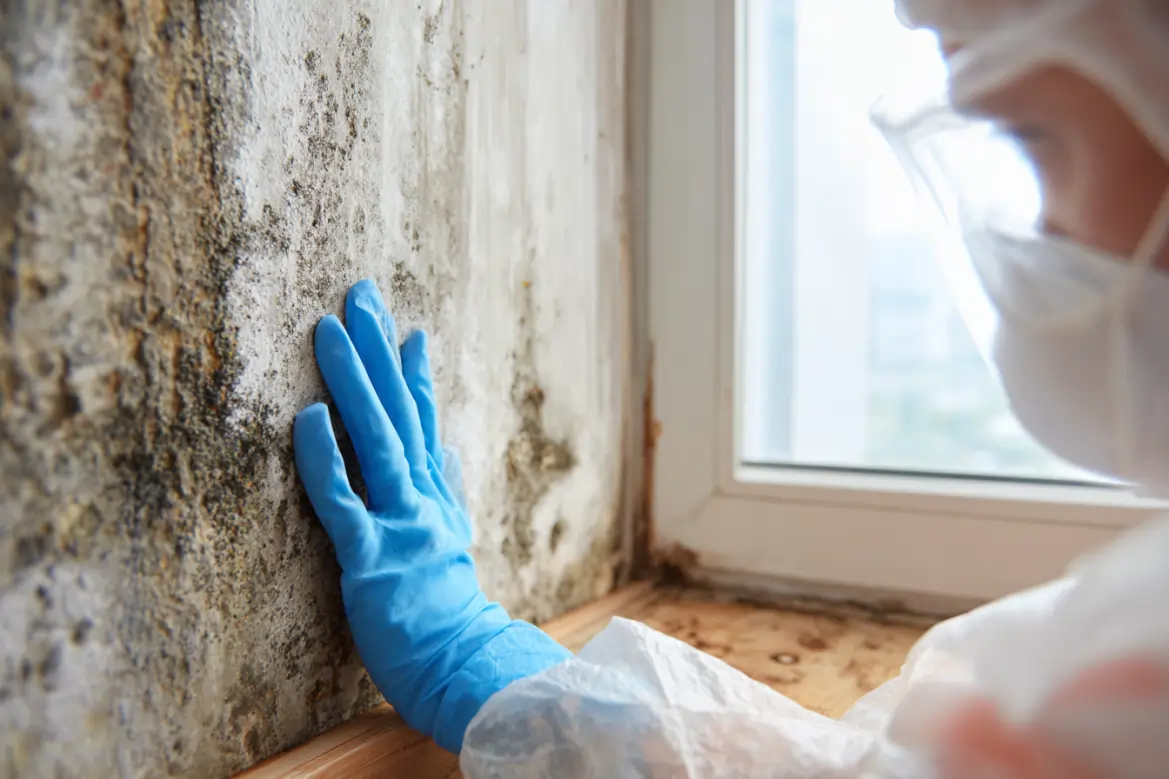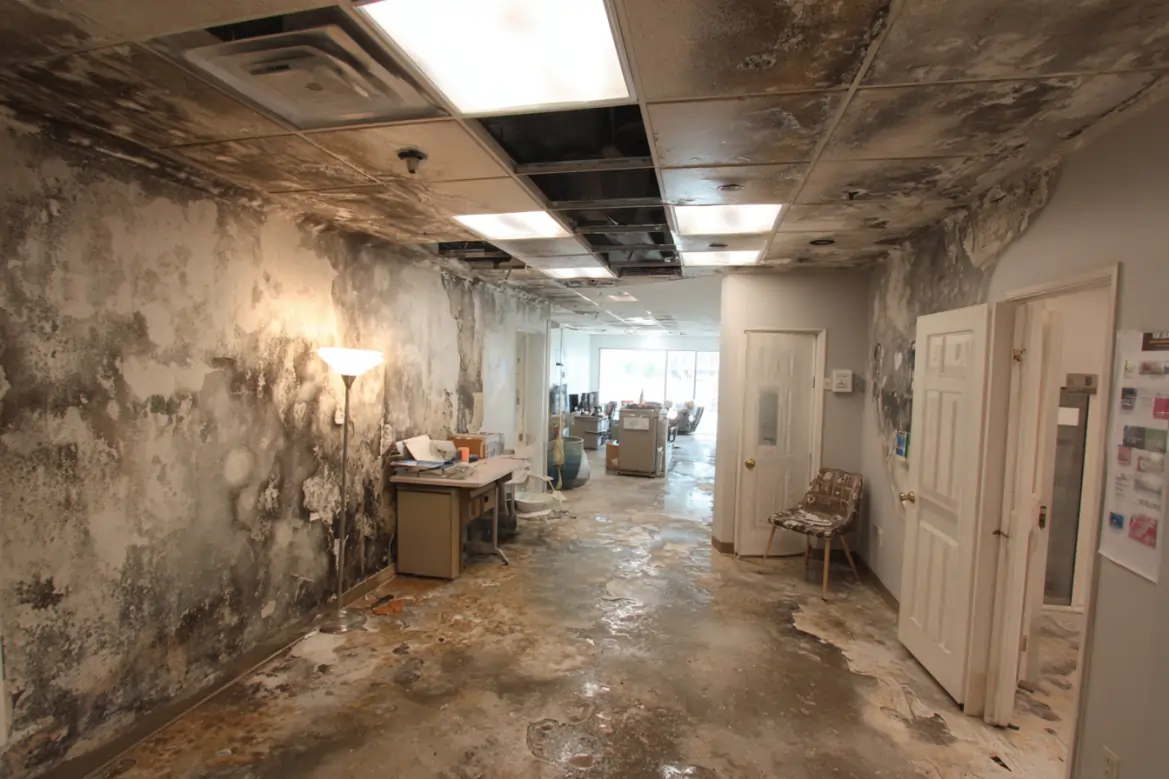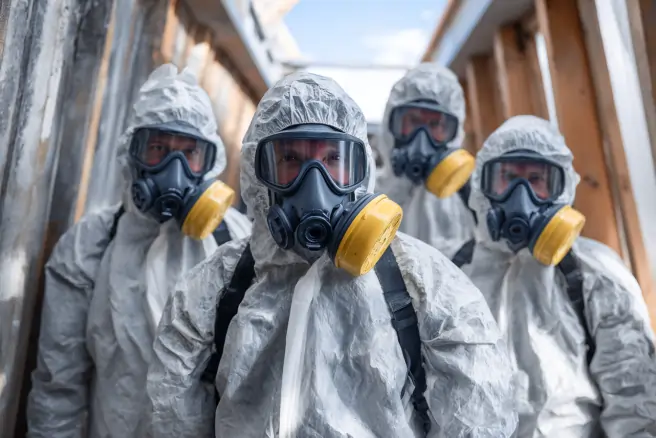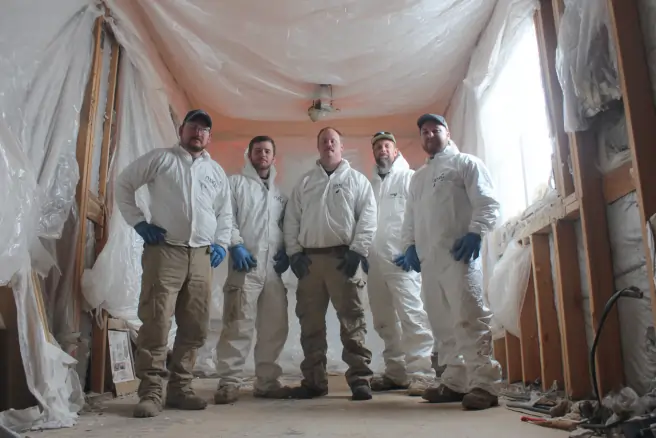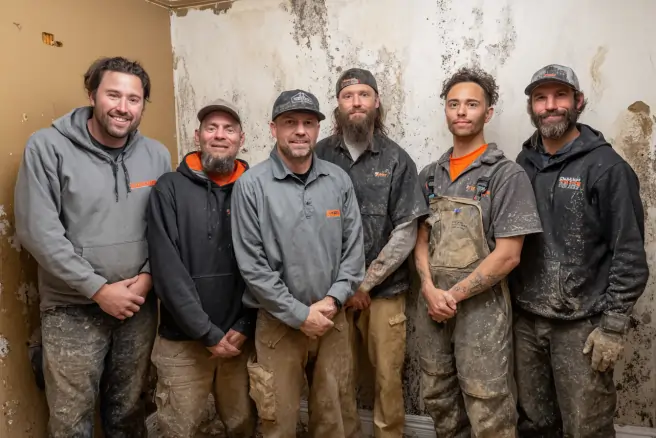
Mold growth in your home can be a serious problem that compromises both your property and your health. While some homeowners may consider handling mold removal on their own, hiring a professional mold remediation service offers numerous advantages. Here, we’ll explore why it’s essential to rely on experts and what you can expect when you do.
Why Hire a Professional Mold Remediation Service?
- Comprehensive Assessment
Professionals begin by conducting a thorough inspection to identify the extent of mold growth. They use specialized tools and techniques to detect mold, even in hidden areas like behind walls or under flooring. - Expertise and Experience
Certified mold remediation specialists are trained to safely and effectively remove mold, ensuring the problem is resolved without spreading spores to other areas. DIY methods often lead to incomplete removal or unintentional contamination. - Safety
Mold, especially toxic varieties like black mold, can be hazardous to your health. Professionals use personal protective equipment (PPE) and containment techniques to minimize exposure and prevent spores from spreading. - Use of Advanced Equipment
Mold remediation experts use high-efficiency air filtration systems, industrial-grade dehumidifiers, and other tools that aren’t typically available to homeowners. This ensures thorough cleanup and helps prevent future mold growth. - Preventing Recurrence
Professional services don’t just remove the existing mold; they also identify and address the underlying causes of mold, such as water leaks or high humidity, to help prevent it from returning.
What to Expect During the Process
| Step | Description |
| Inspection and Assessment | A thorough evaluation of the affected areas to determine the extent and type of mold. |
| Containment | Specialists isolate the affected area using physical barriers and negative air pressure. |
| Air Filtration | High-efficiency particulate air (HEPA) filters capture mold spores and improve air quality. |
| Mold Removal | Mold is carefully removed from surfaces or materials that cannot be salvaged. |
| Cleaning and Sanitization | Remaining surfaces are cleaned and treated with antimicrobial agents to prevent regrowth. |
| Restoration | Damaged materials are repaired or replaced, restoring your home to its original condition. |
Benefits of Professional Services
- Health Protection: Mold exposure can lead to respiratory problems, allergies, and even long-term health issues. Professionals reduce these risks through proper containment and removal.
- Efficiency: Experts complete the process faster and more effectively than DIY methods, saving you time and effort.
- Long-Term Savings: By addressing the root cause and preventing recurrence, professional services help you avoid costly future repairs.
DIY vs.
| Criteria | DIY Approach | Professional Service |
| Effectiveness | Often incomplete; may spread spores | Thorough removal and cleanup |
| Safety | Limited protective measures | Full use of safety protocols |
| Cost | Lower upfront cost | Higher upfront cost but long-term savings |
| Time | Time-consuming | Efficient and faster process |
| Preventive Measures | May overlook underlying causes | Identifies and fixes root issues |
Final Thoughts on Hiring Professionals
Professional mold remediation services provide a reliable, safe, and efficient solution to mold problems. Their expertise, advanced equipment, and comprehensive approach not only remove existing mold but also reduce the risk of recurrence. By leaving this task to trained professionals, you safeguard your home and your health, ensuring a cleaner and safer living environment.
Effective Mold Removal Stuart FL: Causes and Prevention Tips for Your Home
Mold growth is a common issue that many homeowners face, but its causes and prevention methods are not always well understood. Mold thrives in environments that provide moisture, warmth, and organic material for sustenance. Understanding what triggers mold formation can help you take proactive measures to prevent it. Below is an in-depth guide on the causes of mold in homes and practical ways to address them.
Common Causes of Mold in Homes
- Excessive Moisture
Moisture is one of the primary factors that promote mold growth. - Leaking pipes or faucets
- Roof leaks
- Poorly sealed windows or doors
- Humid climates
- Poor Ventilation
A lack of proper air circulation can trap moisture inside your home, creating the perfect conditions for mold to thrive. Spaces like bathrooms, attics, basements, and laundry rooms are particularly vulnerable. - Flooding or Water Damage
Water damage from floods or broken appliances like washing machines can saturate walls, floors, or ceilings, which often leads to mold if immediate cleanup isn’t performed. - Condensation Issues
Condensation often forms on surfaces such as cold walls, windows, or pipes when warm air meets cool surfaces. Over time, this can lead to moisture accumulation and subsequent mold growth. - High Humidity Levels
Indoor humidity levels exceeding 60% create an environment conducive to mold development. High humidity is commonly found in homes without dehumidifiers or proper ventilation systems.
Effective Ways to Prevent Mold Growth
Preventing mold requires a combination of proactive maintenance and environmental control measures.
- Control Indoor Humidity Levels:Keep your home’s humidity between 30-50%. Use dehumidifiers or air conditioners during humid months.
- Fix Leaks Promptly:Repair any plumbing leaks or roof damage immediately to prevent water intrusion.
- Improve Ventilation:Install exhaust fans in high-moisture areas like bathrooms and kitchens. Open windows regularly for better airflow.
- Dry Wet Areas Quickly:After spills or flooding events, dry affected areas within 24-48 hours using fans or professional drying equipment.
- Use Mold-Resistant Products:Consider using paint with mold inhibitors and installing mold-resistant drywall during renovations.
- Insulate Cold Surfaces:Proper insulation helps reduce condensation on cold walls and pipes.
- Clean Gutters Regularly:Clogged gutters can cause water overflow near your foundation, leading to dampness inside your home.
Table: Ideal Environmental Conditions to Prevent Mold Growth
| Factor | Recommended Range/Action |
| Indoor Humidity | 30%-50% |
| Ventilation | Regular airflow; exhaust fan usage |
| Water Damage Cleanup | Within 24-48 hours |
| Materials Used | Mold-resistant paints/drywall |
Red Flags That Signal Potential Mold Problems
- Persistent musty odors.
- Visible discoloration on walls, ceilings, or floors (often black or greenish stains).
- Symptoms like allergies worsening indoors (e. g. , sneezing, itchy eyes).
By identifying the causes of mold early on and implementing preventative measures consistently throughout your home environment, you can reduce the risk of health issues while preserving the integrity of your property over time.
Effective Mold Inspection Stuart FL: Causes and Prevention Tips for Your Home
Mold growth in homes can lead to significant health concerns, structural damage, and expensive remediation efforts. Understanding the root causes of mold and adopting effective prevention measures is essential for maintaining a safe and healthy living environment.
Common Causes of Mold in Homes
Mold thrives in environments rich in moisture and organic material.
- Leaking pipes, roofs, or faucets.
- Flooding incidents that are not promptly addressed.
- Prolonged high humidity levels (above 60%).
- Inadequate airflow promotes moisture buildup, especially in kitchens, bathrooms, basements, and attics.
- Cold surfaces like windows or concrete walls can cause condensation when warm air meets these surfaces.
- Water-damaged drywall, carpeting, insulation, or wood can retain moisture and encourage mold growth.
- Poorly maintained gutters or downspouts can lead to water accumulation near the foundation.
- Mold feeds on materials like wood, paper products, carpets, upholstery fabric, and even dust particles.
Effective Ways to Prevent Mold Growth
- Control Humidity Levels
Keep humidity levels below 50%. Use dehumidifiers or air conditioners in damp spaces like basements during humid weather. - Ensure Proper Ventilation
Install exhaust fans in high-moisture areas such as bathrooms and kitchens to reduce moisture buildup during activities like cooking or showering. Regularly open windows to improve airflow when weather permits. - Fix Leaks Immediately
Address plumbing leaks and roof issues promptly to avoid water seeping into walls or floors where mold can grow unnoticed. - Dry Wet Areas Immediately
After flooding or accidental spills:- Remove excess water using mops or vacuums.
- Thoroughly dry carpets and furniture within 24–48 hours.
- Use fans to speed up drying times for wet areas.
- Improve Drainage Around the Home
Ensure gutters are clean and functioning properly to direct water away from your property’s foundation. Extend downspouts if needed for better water diversion. - Use Mold-Resistant Products During Renovations
Opt for mold-resistant drywall or paint when renovating susceptible areas like basements or bathrooms. - Monitor Ventilation Systems Regularly
Inspect HVAC systems annually for any signs of dampness within ducts that could promote mold growth over time.
| Area of Concern | Recommended Action |
| Bathrooms | Install ventilation fans; wipe surfaces dry after use |
| Roofs & Gutters | Repair leaks; clean gutters regularly |
| Basements | Use dehumidifiers; seal cracks in foundations |
| HVAC Ducts | Perform regular maintenance checks |
The Role of Proper Maintenance
- Look for discoloration on walls and ceilings (a common indicator of moisture).
- Smell your living spaces periodically—musty odors often signal hidden mold presence.
By understanding what causes mold growth and implementing preventive measures consistently throughout your home’s various systems, you can create an environment less hospitable to this unwanted intruder while protecting both the health of your family and the integrity of your property over time.
Effective Mold Remediation Stuart FL Services to Safeguard Your Health
Mold exposure can lead to various health issues, some of which can be severe if left unaddressed. Professional mold cleaning and remediation services provide a crucial solution by not only removing visible mold but also addressing its root causes. This process ensures the safety and well-being of residents by protecting their health. Below, we take an in-depth look at how these services safeguard your health.
Understanding the Health Risks of Mold During Water Damage Restoration Stuart FL
Mold releases microscopic spores into the air, which can be inhaled by people living or working in affected environments.
- Respiratory Issues: Mold spores irritate the respiratory system, leading to coughing, wheezing, and difficulty breathing.
- Allergic Reactions: Symptoms include sneezing, runny nose, skin rashes, and itchy eyes for those sensitive to mold.
- Asthma Complications: For individuals with asthma or other pre-existing lung conditions, exposure may trigger severe episodes.
- Infections: Certain types of mold (e. g. , black mold) may cause infections in immunocompromised individuals.
These risks highlight why it is essential to rely on professionals for effective and thorough removal.
Professional Steps for Mold Remediation Stuart FL to Protect Your Health
Professional mold remediation services employ advanced techniques to ensure both immediate removal and long-term prevention.
- Professionals begin by conducting a detailed inspection of your property.
- They identify all sources of moisture that contribute to mold growth.
- Special equipment like infrared cameras may be used to detect hidden mold colonies behind walls or under flooring.
- Experts use specialized cleaning products that are non-toxic yet effective at eliminating stubborn molds.
- Contaminated areas are sealed off during the process to prevent spores from spreading throughout the property.
- Air filtration systems (HEPA filters) are employed to remove airborne spores from indoor spaces.
- Improved air circulation minimizes exposure risks and restores healthy air quality levels.
- After removing existing growths, technicians focus on moisture control strategies such as dehumidification or repairing leaks that caused initial outbreaks.
- Anti-microbial treatments may be applied on surfaces prone to future contamination.
Discover the Long-Term Health Benefits of Stuart FL Mold Remediation
| Benefit | Description |
| Reduced Allergens | Eliminates not only visible molds but also airborne allergens caused by spore proliferation. |
| Improved Respiratory Health | Helps alleviate breathing difficulties linked with poor indoor air quality due to mold presence. |
| Peace of Mind | Knowing that experts have mitigated root causes reduces stress about recurring health hazards. |
Professional Mold Remediation Stuart FL: Why DIY Solutions Aren’t Enough
While DIY approaches might seem cost-effective initially, they often fail to address underlying issues effectively: – Lack of proper protective equipment increases risk during cleanup. – Incomplete removal leads to recurrent problems over time. – Incorrect handling of contaminated materials might exacerbate spore spread across unaffected areas.
By hiring professionals who adhere strictly to industry standards (e. g.
Top Reasons to Choose Professional Mold Removal Stuart FL Services After Flooding
When a property suffers from flooding, whether due to natural disasters or plumbing issues, the aftermath can lead to significant structural damage and long-term health risks. One of the most effective ways to reduce these risks is by hiring a professional water damage mitigation service. Here are the key benefits of engaging experts to handle water damage effectively.
Flooding can lead to rapid damage in a home, with water seeping into walls, floors, and belongings. Professional water damage mitigation services are equipped to respond quickly, minimizing the extent of the damage.
- Prevents mold growth, which can start within 24-48 hours.
- Reduces repair costs by addressing issues early.
- Protects valuable possessions and structural integrity.
One of the primary advantages of hiring professionals is their ability to thoroughly assess the extent of water damage. They use advanced tools, including moisture meters, thermal imaging cameras, and hygrometers, to identify hidden pockets of water.
- Floors, drywall, and ceilings.
- Crawl spaces and basements.
- HVAC systems and insulation.
This comprehensive evaluation ensures no moisture is left behind, which could otherwise lead to long-term issues.
Standing water and damp areas are breeding grounds for mold. Professional water damage mitigation services not only remove the water but also take proactive measures to prevent mold growth.
- Thorough drying using specialized equipment like industrial dehumidifiers and air movers.
- Application of antimicrobial treatments to affected surfaces.
- Inspection for existing mold and safe removal if found.
By addressing mold risks early, these services help protect the health of occupants and the structural integrity of the home.
Professional services have access to state-of-the-art equipment that homeowners typically do not possess.
- Examples of equipment used:
| Equipment | Purpose |
|————————–|———————————————|
| Industrial-grade pumps | Extract large volumes of water quickly.
| HEPA air scrubbers | Filter airborne contaminants and mold spores.
| Infrared cameras | Detect water hidden behind walls or flooring.
These tools ensure efficient and thorough mitigation that goes beyond surface-level drying.
Water damage mitigation services often assist with insurance claims, simplifying the process for homeowners.
- Documenting damages with photos and detailed reports.
- Providing accurate estimations for repair costs.
- Communicating directly with insurance adjusters to ensure claims are processed efficiently.
This support can save homeowners significant time and effort in dealing with insurers.
While hiring a professional service may seem like an upfront expense, it is often more economical than attempting DIY cleanup or delaying necessary remediation.
- Prevents secondary damage such as mold or structural weakening.
- Protects valuable belongings and reduces replacement costs.
- Ensures compliance with building codes and safety standards.
By addressing water damage comprehensively and quickly, homeowners avoid higher expenses down the line.
Finally, professional water damage mitigation services provide homeowners with peace of mind, knowing that their property is in capable hands. With their expertise, advanced tools, and thorough processes, professionals ensure that all potential risks are managed effectively, leaving the home safe and habitable.
Hiring a water damage mitigation service after flooding is not just a reactive measure but a proactive step toward safeguarding your home and health.
6 Reasons to Hire a Mold Specialist Stuart FL for Air Duct Replacement and Mold Prevention
Mold growth is often a hidden problem, lurking in areas you may not see daily. One of the most overlooked spaces where mold can thrive is within your air duct system. Replacing old or damaged air ducts can help prevent future mold issues, ensuring a healthier and safer environment in your home. Below are six key reasons why air duct replacement is a proactive step in preventing mold growth.
1.Eliminating Existing Mold Contamination
Old air ducts can harbor mold spores and moisture, creating the perfect environment for further contamination. Over time, dust, dirt, and debris accumulate within the ductwork, providing organic material for mold to feed on. By replacing the affected ductwork, you’re removing any existing mold colonies and starting fresh with a clean system.
2.Improving Ventilation and Airflow
Damaged or poorly designed ductwork can hinder proper airflow, creating stagnant areas with high humidity. This stagnant air encourages moisture buildup, which fosters mold growth. Upgrading to a modern duct system with better airflow design reduces humidity levels and minimizes the risk of mold developing in the future.
3.Reducing Moisture with New Materials
Older duct systems may lack insulation or be made from materials prone to condensation. Modern air ducts are often designed with moisture-resistant materials and better insulation, reducing the likelihood of condensation forming inside the ductwork. Lower moisture levels mean less opportunity for mold to thrive.
| Feature | Old Ducts | New Ducts |
| Material Susceptibility | High | Low |
| Moisture Resistance | Poor | Good |
| Insulation Quality | Minimal | Improved |
4.Preventing Cross-Contamination
If your current ductwork is contaminated with mold, turning on your HVAC system can distribute those spores throughout your living space. This cross-contamination poses health risks such as allergies, respiratory problems, and other health concerns. Replacing the ducts ensures that the spores are eliminated at the source, preventing further spread.
5.Enhancing Indoor Air Quality
Airborne mold spores can significantly impact indoor air quality, especially for individuals with asthma or allergies. By replacing old ducts that may harbor pollutants, you’re investing in cleaner, healthier air for your household. New ductwork reduces the chances of mold spores circulating through your HVAC system, creating a safer environment for occupants.
6.Addressing Structural Damage in the Ductwork
Cracks, gaps, or tears in old duct systems can result in leaks that allow moisture to enter. These issues can create isolated pockets of dampness, which are ideal for mold growth. New ductwork eliminates these structural vulnerabilities, providing a sealed and secure system that keeps moisture and contaminants out.
Proactive Steps for Mold Prevention in Air Ducts
- Regular Maintenance:Schedule annual inspections and cleanings of your HVAC system.
- Use a Dehumidifier:Control indoor humidity levels to keep them below 60%.
- Replace Filters Frequently:Use high-quality air filters and replace them every 1–3 months.
- Seal Leaks:Ensure the entire HVAC system, including ducts, is properly sealed to prevent moisture entry.
- Monitor Drain Lines:Keep an eye on condensate drain lines to ensure they remain unclogged.
Replacing air ducts is an effective way to address existing mold problems and prevent future issues. This investment not only safeguards your home against mold but also promotes better health and comfort for everyone inside.
7 Effective Solutions a Mold Remediation Service Provides for Your Home
When dealing with mold infestations, it’s crucial to rely on professional mold remediation services to ensure safe and effective removal. Not only do they eliminate visible mold, but they also address underlying issues to prevent recurrence.
1.Comprehensive Mold Inspection and Testing
Professional services begin with a detailed inspection and testing process.
– The type of mold present (e. g. , black mold, white mold).
– The extent of the infestation.
– Hidden areas where mold might be growing, such as behind walls or under flooring.
This evaluation allows experts to tailor their approach to the specific needs of your home.
2.Containment to Prevent Spread
Mold spores are microscopic and can easily spread through the air during removal.
– Sealing off affected areas with plastic sheeting.
– Using negative air pressure systems to prevent spore migration into unaffected areas of the home.
Proper containment minimizes contamination risks and keeps your indoor environment safe.
3.Safe Removal of Contaminated Materials
In severe cases, porous materials like drywall, insulation, or carpeting may be too compromised by mold growth and require removal. Mold remediation teams follow strict safety protocols for disposing of contaminated materials without endangering household members or spreading spores further.
| Material Type | Action Taken | Reason |
| Drywall | Removal | Porous surface absorbs mold spores deeply |
| Carpeting | Replacement | Fibers trap moisture and spores |
| Insulation | Replacement | Cannot be cleaned effectively |
4.Thorough Cleaning Using Specialized Equipment
Once contaminated materials are removed, professionals clean all affected surfaces using specialized methods such as:
– HEPA vacuuming to trap microscopic spores. – Wet wiping using EPA-approved biocides or fungicides that kill residual mold. – Abrasive cleaning techniques like soda blasting for stubborn infestations on tough surfaces like wood or concrete.
These methods ensure both visible and invisible traces of mold are eradicated.
5.Moisture Control Measures
Since moisture is the main driver behind most mold problems, professionals identify and address sources of excess humidity in your home.
– Fixing leaking pipes or roofs immediately. – Improving ventilation in areas prone to dampness (e. g. , bathrooms and basements).
– Installing dehumidifiers in high-humidity zones.
These proactive steps reduce the likelihood of future infestations.
6.Air Filtration Systems
To improve indoor air quality during the remediation process, professionals often use industrial-grade air scrubbers equipped with HEPA filters that capture airborne spores, dust particles, and other contaminants. This ensures that your living environment is restored to a healthier state after active remediation efforts are completed.
7.Preventive Recommendations Post-Service
After completing the cleanup process, reputable remediation companies provide tailored advice on how you can maintain a mold-free home environment moving forward:
– Regularly check areas prone to leaks or dampness (e. g. , under sinks, basement corners).
– Monitor relative indoor humidity levels (ideally between 30%-50%).
– Ensure proper drainage around your property’s foundation.
By addressing root causes and equipping homeowners with prevention strategies, these services go beyond mere removal to deliver long-term solutions.
Relying on professional expertise from contractors like Stuart Mold Removal not only ensures effective eradication but also protects your family’s health while preserving the structural integrity of your home for years ahead.
6 Reasons Why Air Duct Replacement Can Help Prevent Future Mold Issues
Mold growth within a home can lead to health complications and structural damage, often arising from overlooked areas such as air ducts. Replacing air ducts can be a proactive step in controlling mold-related problems. Below are six compelling reasons why air duct replacement can reduce the risk of future mold issues.
When air ducts become contaminated with mold spores, cleaning alone may not always address the issue. In some cases, mold colonies embed deep within the duct materials, making them difficult to eliminate effectively. Replacing the ducts ensures complete removal of contaminated surfaces and prevents the reintroduction of mold spores into your home’s air supply.
Old or poorly designed air ducts can restrict airflow, leading to increased humidity in the system. High humidity is a key factor in mold growth. Upgrading to modern air duct systems with improved airflow capabilities reduces moisture accumulation, creating conditions that are less favorable for mold development.
Cracks, gaps, or other damage in older air ducts can provide spaces where moisture can accumulate and mold can thrive. Replacing damaged ductwork removes these problem areas and seals potential entry points for moisture, significantly lowering the risk of mold growth. Properly sealed ducts also improve energy efficiency, making it a dual-benefit solution.
Air ducts can collect dust, dirt, and organic debris over time, which can serve as a food source for mold spores. Replacing old ductwork eliminates years of accumulated debris. Furthermore, new systems are often designed with smoother interiors that resist the build-up of dust and other contaminants, helping to maintain cleaner air circulation.
Older air duct systems may lack proper insulation, resulting in condensation forming on their surfaces. Condensation creates the perfect environment for mold to grow. Modern duct materials often include better insulation properties, reducing the likelihood of condensation and subsequent mold formation.
Mold spores circulating through air ducts can compromise indoor air quality, leading to respiratory issues and allergies for occupants. Replacing air ducts ensures that any lingering spores are eliminated, promoting a healthier living environment. In addition, newer duct systems often use advanced filtration technologies to trap airborne particles before they can settle and grow into mold colonies.
Summary Table: Benefits of Air Duct Replacement
| Reason | Impact |
| Removal of Contaminated Ductwork | Eliminates existing mold and prevents reintroduction of spores. |
| Improved Ventilation and Airflow | Reduces humidity and moisture accumulation, deterring mold growth. |
| Elimination of Damaged Sections | Removes gaps and cracks that can harbor mold or allow moisture build-up. |
| Reduction of Dust and Debris | Limits organic materials that could serve as food for mold spores. |
| Improved Resistance to Condensation | Prevents damp conditions that encourage mold growth. |
| Enhanced Indoor Air Quality | Promotes a healthier environment by removing airborne spores. |
Taking proactive steps, such as air duct replacement, is an essential part of maintaining a mold-free and healthy home environment. By addressing potential problem areas in your HVAC system, you can significantly reduce the risk of future mold growth while improving overall indoor air quality and energy efficiency.

